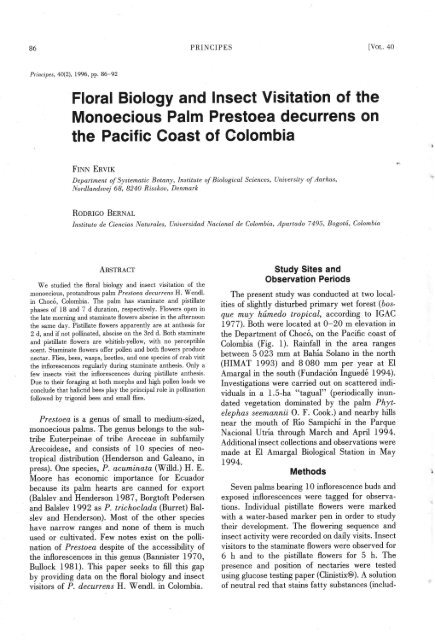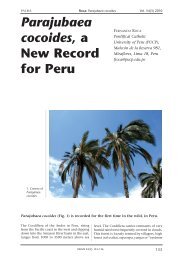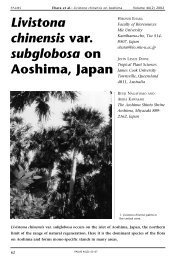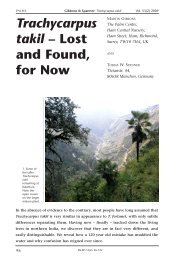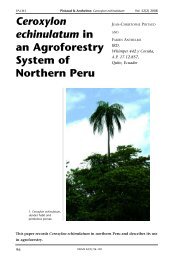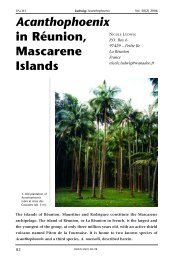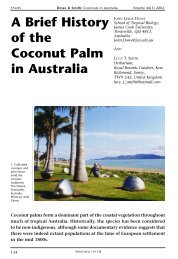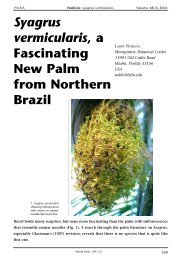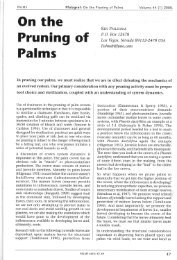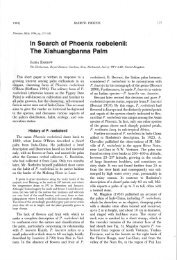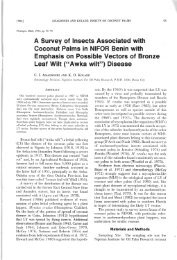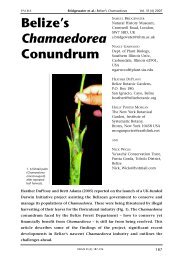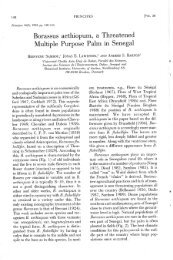Monoecious Palm Prestoea decurrens on - International Palm Society
Monoecious Palm Prestoea decurrens on - International Palm Society
Monoecious Palm Prestoea decurrens on - International Palm Society
Create successful ePaper yourself
Turn your PDF publications into a flip-book with our unique Google optimized e-Paper software.
86<br />
PRINCIPES [Vor. 40<br />
P rincipes, 40(21, 1996, pp. 86-92<br />
Floral Biology and Insect Visitati<strong>on</strong> of the<br />
<str<strong>on</strong>g>M<strong>on</strong>oecious</str<strong>on</strong>g> <str<strong>on</strong>g>Palm</str<strong>on</strong>g> <str<strong>on</strong>g>Prestoea</str<strong>on</strong>g> <str<strong>on</strong>g>decurrens</str<strong>on</strong>g> <strong>on</strong><br />
the Pacific Coast of Golombia<br />
FnN Envx<br />
Department of Systematic Botany, lnstitute of Biological Sciences, Uniuersity of Aarhus'<br />
Nordlandsaej 68, B24O Risskoa, Dennark<br />
Ro<strong>on</strong>rco BnRNer<br />
Instituto de Ciencias Naturales, (Iniaersidad Naci<strong>on</strong>al de Colornbia, Apartado 7495, Bogotri, Colombia<br />
Assrnecr<br />
We studied the floral biology and insect visitati<strong>on</strong> of the<br />
m<strong>on</strong>oecious, protandrous palm <str<strong>on</strong>g>Prestoea</str<strong>on</strong>g> <str<strong>on</strong>g>decurrens</str<strong>on</strong>g> H. Wendl.<br />
in Choc6, Colombia. The palm has staminate and pistillate<br />
phases of 18 and 7 d durati<strong>on</strong>, respectively. Flowers open in<br />
the late morning and staminate flowers abscise in the afterno<strong>on</strong><br />
the same day. Pistillate flowers apparently are at anthesis for<br />
2 d, and if not pollinated, abscise <strong>on</strong> the 3rd d. Both staminate<br />
and pistillate flowers are whitish-yellow, with no perceptible<br />
scent. Staminate flowers offer pollen and both flowers produce<br />
nectar. Flies, bees, wasps, beetles' and <strong>on</strong>e species of crab visit<br />
the inflorescences regularly during staminate anthesis. Only a<br />
few insects visit the inflorescences during pistillate anthesis'<br />
Due to their foraging at both morphs and high pollen loads we<br />
c<strong>on</strong>clude that halictid bees play the principal role in pollinati<strong>on</strong><br />
followed by trig<strong>on</strong>id bees and small flies.<br />
<str<strong>on</strong>g>Prestoea</str<strong>on</strong>g> is a genus of small to medium-sized,<br />
m<strong>on</strong>oecious palms. The genus bel<strong>on</strong>gs to the subtribe<br />
Euterpeinae of tribe Areceae in subfamily<br />
Arecoideae, and c<strong>on</strong>sists of I0 species of neotropical<br />
distributi<strong>on</strong> (Henders<strong>on</strong> and Galeano, in<br />
press). One species, P. acum.inata (Willd.) H. E.<br />
Moore has ec<strong>on</strong>omic importance for Ecuador<br />
because its palm hearts are canned for export<br />
(Balslev and Henders<strong>on</strong> 1987, Borgtoft Pedersen<br />
and Balslev L992 as P. trichoclnda (Burret) Balslev<br />
and Henders<strong>on</strong>). Most of the other species<br />
have narrow ranges and n<strong>on</strong>e of them is much<br />
used or cultivated. Few notes exist <strong>on</strong> the pollinati<strong>on</strong><br />
of <str<strong>on</strong>g>Prestoea</str<strong>on</strong>g> despite of the accessibility of<br />
the inflorescences in this genus (Bannister 1970,<br />
Bullock 1981). This paper seeks to fill this gap<br />
by providing data <strong>on</strong> the floral biology and insect<br />
visitors of P. <str<strong>on</strong>g>decurrens</str<strong>on</strong>g> H. Wendl. in Colombia.<br />
Study Sites and<br />
Observati<strong>on</strong> Periods<br />
The present study was c<strong>on</strong>ducted at two localities<br />
of slightly disturbed primary wet forest (bosque<br />
nuy hirnedo tropical, according to IGAC<br />
1977). Both were located at 0-20 m elevati<strong>on</strong> in<br />
the Department of Choc6, <strong>on</strong> the Pacific coast of<br />
Colombia (Fig. l). Rainfall in the area ranges<br />
between 5 023 mm at Bahia Solano in the north<br />
(HIMAT 1993) and B 080 mm per year at EI<br />
Amargal in the south (Fundaci6n Ingued6 1994).<br />
Investigati<strong>on</strong>s were carried out <strong>on</strong> scattered individuals<br />
in a 1.5-ha "tagual" (periodically inundated<br />
vegetati<strong>on</strong> dominated by the palm Phytelephas<br />
seemannii O. F. Cook.) and nearby hills<br />
near the mouth of Rio Sampichi in the Parque<br />
Naci<strong>on</strong>al Utria through March and April 1994.<br />
Additi<strong>on</strong>al insect collecti<strong>on</strong>s and observati<strong>on</strong>s weie<br />
made at El Amargal Biological Stati<strong>on</strong> in May<br />
1994.<br />
Methods<br />
Seven palms bearing l0 inflorescence buds and<br />
exposed inflorescences were tagged for observati<strong>on</strong>s.<br />
Individual pistillate flowers were marked<br />
with a water-based marker pen in order to study<br />
their development. The flowering sequence and<br />
insect activity were recorded <strong>on</strong> daily visits. Insect<br />
visitors to the staminate flowers were observed for<br />
6 h and to the pistillate flowers for 5 h. The<br />
presence and positi<strong>on</strong> of nectaries were tested<br />
using glucose testing paper (Clinistix@). A soluti<strong>on</strong><br />
of neutral red that stains fatty substances (includ-
e96l<br />
ERVIK AND BERNAL: FLORAL BIOLOGY OF PRESTOEA DECURRENS<br />
Bohio<br />
6ol5l<br />
El\bild<br />
b\----t.-r-<br />
,rl<br />
--'od\ .i<br />
N erW<br />
\\<br />
\\<br />
a<br />
(<br />
o<br />
o\<br />
I-,<br />
! I t<br />
urRrA<br />
\ i<br />
,^q9. NATIONAL PARK \<br />
7<br />
6o00l<br />
PACIFIC OCEAN<br />
I<br />
t<br />
/,'----i -Y*"Ho'<br />
Jurubido'<br />
GOLFO<br />
DETRIBUGA<br />
Nuqui<br />
ibugd<br />
50<br />
Arusf<br />
(couoYorrienres<br />
o 5 r o 1 5 2 0 2 5<br />
-<br />
l. Locati<strong>on</strong> of the Gulf of Tribug6. Study sites are marked with stars.
PRINCIPES [Vor-. 40<br />
staminate flowedng<br />
Time of Day<br />
06 08 10 12 14 16 18<br />
----xxxxxxx-------<br />
s<br />
P<br />
s<br />
P<br />
s<br />
P<br />
++++++++++++++++++#+<br />
+++*++i*********+*++<br />
++++++++++t<br />
+#+#+++++++++++<br />
++++++++++++++<br />
Daily vuiati<strong>on</strong><br />
in <strong>on</strong>wt md end of flowering<br />
xxxxxsxn<br />
Genemlflowering<br />
High rctivity<br />
++++++++ lrwer rctivity<br />
3. The diurnal pattern of visitati<strong>on</strong> of the different insect<br />
groups to inflorescences of <str<strong>on</strong>g>Prestoea</str<strong>on</strong>g> <str<strong>on</strong>g>decurrens</str<strong>on</strong>g> in relati<strong>on</strong> to<br />
flowering. S: visitati<strong>on</strong> to staminate phase inflorescences. P:<br />
visitati<strong>on</strong> to pistillate phase inflorescences.<br />
of the species and <strong>on</strong>e genus in order to make<br />
possible comparis<strong>on</strong>s with other publicati<strong>on</strong>s of the<br />
specialists (see Acknowledgments) or the authors.<br />
- 2. Inflorescence oI <str<strong>on</strong>g>Prestoea</str<strong>on</strong>g> d'ecurrens.<br />
ing oil-c<strong>on</strong>taining cells) was used to test for the<br />
presence of pollen kitt and scent-producing floral<br />
parts (Vogel 1990). The temperature ofa selected<br />
inflorescence was measured before and after splitting<br />
of the peduncular bract. A digital thermometer<br />
with a 2 mm diameter probe was inserted in<br />
the center of the bud or flower-bearing parts. In<br />
order to reveal the specfficity of the visitors to<br />
<str<strong>on</strong>g>Prestoea</str<strong>on</strong>g> decunens, insects were also collected<br />
<strong>on</strong> several co-existing palm or palmJike species,<br />
including Cocos nucifera L., Phytelephas seemannii<br />
O. F. Cook, Welf.a regia H. Wendl. ex<br />
Andr6 (<str<strong>on</strong>g>Palm</str<strong>on</strong>g>ae), Asplundia sp., and Carludoaica<br />
palmata Ruiz and Pav. (Cyclanthaceae). Vouchers<br />
of the palm have been deposited at AAU, COL,<br />
and FMB. Insect vouchers have been deposited<br />
in the entomological collecti<strong>on</strong>s at Instituto de<br />
Ciencias Naturales, Universidad Naci<strong>on</strong>al de<br />
Colombia, at INDERENA, BogotS, at the Zoological<br />
Museum, University of Aarhus, and at the<br />
respectiye instituti<strong>on</strong>s of the specialists that helped<br />
with identificati<strong>on</strong>s. Numbers are given to some<br />
Results<br />
<str<strong>on</strong>g>Prestoea</str<strong>on</strong>g>. <str<strong>on</strong>g>decurrens</str<strong>on</strong>g> is a medium-sized cespitose<br />
palm with 2-7 stems up to 7 m tall and 12 cm<br />
in diameter. It is comm<strong>on</strong> al<strong>on</strong>g rivers and streams<br />
in Iowland wet forests from Nicaragua to western<br />
Ecuador. Inflorescences of P. <str<strong>on</strong>g>decurrens</str<strong>on</strong>g> are<br />
branched to <strong>on</strong>e order with 36-68 rachillae (X:<br />
50.3, 1[: 7) (Fig. 2) that are enclosed in bud by<br />
a single, slender peduncular bract. Flowers are<br />
unisexual and generally grouped in triads of two<br />
lateral staminate and <strong>on</strong>e central pistillate flower.<br />
The development of the pistillate flowers is often<br />
suppressed at the distal end of each rachillae,<br />
resulting in staminate dyqds. Each rachilla bears<br />
from 206 to 320 triads (X : 268.3,1f : 4) and<br />
from two to 18 dyads (X: 6.5, N: 4). Flowers<br />
of both morphs are whitish-yellow with no perceptible<br />
odor. The filaments and the c<strong>on</strong>nectives<br />
stained weakly red with neutral red. This may<br />
indicate that these tissues produce a very weak<br />
scent. No other tissues in the inflorescence changed<br />
color. Staminate flowers offer pollen and both staminate<br />
and pistillate flowers produce nectar. Pollen<br />
of P. decunens is sticky. It stained when<br />
treated with neutral red, which indicates presence<br />
of pollen kitt.<br />
The individuals studied flowered throughout the<br />
period of observati<strong>on</strong>; and the presence of buds
9961<br />
ERVIK AND BERNAL: FLORAL BIOLOCY OF PRESTOEA DECURRENS<br />
B9<br />
Table 1. Visitors to the inf.orescences olf<str<strong>on</strong>g>Prestoea</str<strong>on</strong>g> <str<strong>on</strong>g>decurrens</str<strong>on</strong>g>. Relatiae abundances are indicated<br />
as follows: aery comm<strong>on</strong> (***), c<strong>on</strong>'nrl<strong>on</strong> (**), ur"o*rn<strong>on</strong> (*), and not obseraed ( ). Localities<br />
at which the insects were obserued: A: El Amalgal, S : Sampichl. Insects obseraed <strong>on</strong> other hosts<br />
were marked with a nurnber and letter (s : staminate, p : pistillate) referring to host plant<br />
species and its phase. Cocos nucifera (1), Phytelephas seemannii (2) , WeIfra regia (3), Asplundia<br />
sp. (4) , and Carludovica palmata (5) .<br />
Order,/Family<br />
Subfamily or tribe<br />
Staminate<br />
Phase<br />
Pisti.<br />
late<br />
Other<br />
Phase Locality Hosts *<br />
Coleoptera<br />
Chrysomelidae<br />
Alticinae<br />
Galerucinae<br />
Curculi<strong>on</strong>idae<br />
Baridinae, Centrinini<br />
Cholinae<br />
Erirhininae, Derelomini<br />
Staphylinidae<br />
Aleocharinae<br />
Brasilaphth<strong>on</strong>a sp. 2<br />
Near Centralaphth<strong>on</strong>a sp. I<br />
Near C. sp. 3<br />
Hypolampsis sp. 3<br />
M<strong>on</strong>olepta sp.<br />
B<strong>on</strong>dariella sp. 3<br />
Cholus cananchensis Heller<br />
Phyllotrox sp. 27<br />
P. sp. 28<br />
Genus 2, sp. I<br />
Amaz<strong>on</strong>charis?<br />
A<br />
S<br />
S<br />
A<br />
A<br />
S<br />
A,S<br />
S<br />
* s<br />
S<br />
4s, 5s<br />
5s<br />
5s<br />
Diptera<br />
Cecidomyidae<br />
Chloropidae<br />
Drosophilidae<br />
- Milichiidae<br />
Mycetophilidae<br />
Cecidomldae sp. I<br />
C. sp. 2<br />
C. sp. 3<br />
Chloropidae sp. I<br />
Drosophila sp.<br />
Milichiidae sp. I<br />
Mycetophilidae sp. I<br />
S<br />
s<br />
S<br />
A<br />
S<br />
A<br />
S<br />
Hymenoptera<br />
Apidae<br />
Melip<strong>on</strong>inae<br />
Halictidae<br />
Plebeia aff. minima (Gribodo)<br />
Trig<strong>on</strong>a spinipes<br />
T. uilliana Friese<br />
Dialictus sp.<br />
Neocorynura sp.<br />
Undet. sp. I<br />
Undet. sp. 2<br />
Undet. sp. 3<br />
A,S<br />
S<br />
S<br />
A,S<br />
A,S<br />
A,S<br />
S<br />
S<br />
2s/p<br />
Dempoda<br />
Grapsidae<br />
Sesarma cf. miersii Rathbun<br />
S<br />
of different degrees of development suggests that<br />
this species flowers throughout the year, a fact<br />
c<strong>on</strong>firmed by G. Galeano (pers<strong>on</strong>al communicati<strong>on</strong>).<br />
<str<strong>on</strong>g>Prestoea</str<strong>on</strong>g> <str<strong>on</strong>g>decurrens</str<strong>on</strong>g> is protandrous with no<br />
overlap between staminate and pistillate phases.<br />
All flowers are closed at the splitting of the bract<br />
and no insects are present. This situati<strong>on</strong> may last<br />
for up to I d until 9:00 to ll:30 a.m. when the<br />
first staminate flowers open and anthers dehisce<br />
(Fig. 3). Individual staminate flowers are <strong>on</strong>ly at<br />
anthesis for a few hours and abscise in the afterno<strong>on</strong><br />
the same day. The staminate phase of the<br />
inflorescence lasts 18 d, with daily pulses of up<br />
to I 000 flowers per inflorescence. Then there is<br />
a pause lasting two days which is followed by a<br />
pistillate phase seven days l<strong>on</strong>g. Pistillate flowers<br />
also open between 9:00 and I l:30 a.m. The stigmas<br />
remain humid and whitish-yellow for 2 d and<br />
are probably receptive this l<strong>on</strong>g. On the 3rd d<br />
they turn brownish, and the flowers either drop
PRINCIPES lVoL. 40<br />
off or start to develop into fruits. No rise in temperature<br />
was recorded before or during anthesis.<br />
At least 26 species of insects and <strong>on</strong>e species<br />
of crab regularly visited the inflorescences of P.<br />
<str<strong>on</strong>g>decurrens</str<strong>on</strong>g> during the staminate phase (Fig. 3,<br />
Table l). Halictid bees came in tens and were the<br />
most c<strong>on</strong>spicuous and numerous insects. They<br />
moved al<strong>on</strong>g the rachillae and busily collected<br />
pollen. We observed that at least <strong>on</strong>e species stored<br />
pollen grains <strong>on</strong> the ventral side of its body. Each<br />
insect usually foraged for several minutes before<br />
Ieaving. Also melip<strong>on</strong>id bees collected pollen, but<br />
they were usually fewer than the halictids. Small<br />
flres (Drosophila, Chloropidae, Milichiidae, Otitidae)<br />
often visited the staminate flowers by the<br />
tens. They were all observed to forage <strong>on</strong> nectar.<br />
Whether they also eat pollen is unclear. Less than<br />
30 individuals of small chrysomelids and curcu-<br />
Ii<strong>on</strong>ids visited the inflorescences particularly during<br />
daytime. They fed <strong>on</strong> pollen grains and nectar<br />
and used the inflorescence as a site for copulati<strong>on</strong>.<br />
Usually a few individuals (< 5) deviated by staying<br />
over night <strong>on</strong> the inflorescences, mostly resting<br />
inactive al<strong>on</strong>g the rachillae. The most c<strong>on</strong>spicuous<br />
of the beetles was Cholus cananchensis, a l0 mm<br />
l<strong>on</strong>g, yellow and black curculi<strong>on</strong>id. A few of them<br />
(
19961<br />
ERVIK AND BERNAL: FLORAL BIOLOGY OF PRESTOEA DECURRENS<br />
9I<br />
I<br />
I<br />
H. Wendl., and different studies have actually<br />
dem<strong>on</strong>strated that drosophilids did not carry any<br />
or <strong>on</strong>ly little pollen when visiting pistillate flowers<br />
of the palmsliphanes erinacea(Karst.) H. Wendl.<br />
(Borchsenius I 993), Aphandra natalia (Henders<strong>on</strong><br />
& Balslev) Barfod (Ervik 1993), and. Phytelephas<br />
seemannii (Bernal and Ervik, in press).<br />
The melip<strong>on</strong>ids usually collect pollen <strong>on</strong> many<br />
different taxa of plants (Heithaus 1979) (i.e., they<br />
are polytropic, see Grant 1949, Eaegri and van<br />
der Pijl l9B0) and Trig<strong>on</strong>a williana was much<br />
more abundant at the inflorescences of the nearby<br />
and abundantly flowering Phytelephas seemannii<br />
(Bernal and Ervik, in press). The probability was<br />
therefore high that the melip<strong>on</strong>ids brought more<br />
foreign than co-specific pollen when visiting pistillate<br />
flowers of P. d.ecurrezs. The halictids, in<br />
c<strong>on</strong>trast, were oligotropic (visiting some related<br />
taxa ofplants <strong>on</strong>ly) or apparently even m<strong>on</strong>otropic<br />
(visiting <strong>on</strong>e single or some closely related plant<br />
species <strong>on</strong>ly). We never observed them <strong>on</strong> any<br />
other plant species. There is therefore a high<br />
chance that they bring exclusively co-specific pollen.<br />
Both the behavior and abundance of the halictids<br />
(Table l) and their potentially large pollen<br />
loads suggest that they were the most important<br />
pollinators of P. <str<strong>on</strong>g>decurrens</str<strong>on</strong>g>. Populati<strong>on</strong>s of bees<br />
are, however, often varying in both compositi<strong>on</strong><br />
and size during the year. This phenomen<strong>on</strong> is<br />
correlated with the degree of sociality: eusocial<br />
bees are less seas<strong>on</strong>al than solitary bees (Heithaus<br />
1979). The family Halictidae exhibits a wide range<br />
of social systems. We do not know the degree of<br />
sociality or seas<strong>on</strong>ality of the Halictidae visiting<br />
P. <str<strong>on</strong>g>decurrens</str<strong>on</strong>g> and therefore cannot rule out the<br />
possibility that the fauna of bees pollinating <str<strong>on</strong>g>Prestoea</str<strong>on</strong>g><br />
<str<strong>on</strong>g>decurrens</str<strong>on</strong>g> changes during the year. Bullock<br />
(I9Bl) observed a whole set of different species<br />
of bees visiting P. <str<strong>on</strong>g>decurrens</str<strong>on</strong>g> flowers in Costa Rica<br />
from December to September. These included two<br />
species of Trig<strong>on</strong>a, or'e Neocorynura, orre<br />
Lasioglossum, and <strong>on</strong>e unidentified Halictidae.<br />
Bullock suggested that bees were the pollinators,<br />
but did not point to any species as being particularly<br />
important.<br />
The general morphology and phenology in<br />
<str<strong>on</strong>g>Prestoea</str<strong>on</strong>g> agree well with the syndrome of bee<br />
pollinati<strong>on</strong> (melittophily) in palms suggested by<br />
Henders<strong>on</strong> (1986). Melittophily is likely to be a<br />
widespread pollinati<strong>on</strong> syndrome in <str<strong>on</strong>g>Prestoea</str<strong>on</strong>g>. A<br />
study by Bannister (1970) supports this assumpti<strong>on</strong>.<br />
She reported rhal <str<strong>on</strong>g>Prestoea</str<strong>on</strong>g> acumina'tcr'<br />
(Willd.) H. E. Moore (as Euterpe globosaGaertn.)<br />
was protandrous with a very short overlap between<br />
staminate and pistillate phases in Puerto Rico. She<br />
c<strong>on</strong>sidered "h<strong>on</strong>eybees and small flieso' to be pollinators.<br />
In the palm family melittophily al<strong>on</strong>g with cantharophily<br />
and myiophily are c<strong>on</strong>sidered the major<br />
- pollinati<strong>on</strong> syndromes (Henders<strong>on</strong> 1986). Later<br />
studies have added new documentati<strong>on</strong> to this<br />
statement (Z<strong>on</strong>a I9B7 ,Bagh L996). Halictid bees,<br />
however, have not been addressed any special<br />
attenti<strong>on</strong>, although they often visit palms (Olesen<br />
and Balslev 1990) and also participate in the pollinati<strong>on</strong><br />
of at least some palms including Sobol<br />
(Z<strong>on</strong>a I9B7 and references therein).<br />
Acknowledgments<br />
Support for F. Ervik came from the EEC (grant<br />
No. TS3-CT91-004). R. Bernal thanks the Universidad<br />
Naci<strong>on</strong>al de Colombia, for a leave of<br />
absence, DANIDA for a study fellowship, and The<br />
Charles A. Lindbergh and Anne Morrow Lindbergh<br />
Foundati<strong>on</strong>, C<strong>on</strong>servati<strong>on</strong> Internati<strong>on</strong>al,<br />
Fundaci6n Ingued6, and The Internati<strong>on</strong>al Foundati<strong>on</strong><br />
for Science, for support of different stages<br />
of the research. INDERENA and the Colombian<br />
Ministry of Envir<strong>on</strong>ment (particularly A. Repizzo,<br />
L. A. Escobar, and park pers<strong>on</strong>nel) facilitated field<br />
work in the Utria Nati<strong>on</strong>al Park. S. Fern6ndez<br />
prepaied the map. We are grateful to the following<br />
specialists who identified the visitors: R. W. FIowers<br />
(Chrysomelidae), D. A. Grimaldi (Drosophili<br />
dae, Milichiidae, Chloropidae), G. Nates (Apidae),<br />
C. W. O'Brien (Curculi<strong>on</strong>idae), M. Rocha (Grapsidae),<br />
D. Roubik (Apidae). We also want to thank<br />
A. Barfod and A. Henders<strong>on</strong> for critical readine<br />
of the manuscript.<br />
Lrrnnerune CIrro<br />
BALSLEv, H. ano A. HENDERSoN. 1987.. Presloea <str<strong>on</strong>g>Palm</str<strong>on</strong>g>ito.<br />
Principes 3I: II.<br />
BaNttsmn, B. A. 1970. Ecological life cycle of Euterpe<br />
globosa Gaerrn. In: H. T. Odum and R. F. Pige<strong>on</strong> (eds.).<br />
A tropical rain forest: a study of irradiati<strong>on</strong> and ecology.<br />
Atomic Energy Comissi<strong>on</strong>, Oak Ridge, Temessee, U.S.A.<br />
BERNAL, R. AND F. EnvIr. In press. Florhl biology and<br />
pollinati<strong>on</strong> of the dioecious palm Phytelephas seemannii<br />
in Colombia: an adaptati<strong>on</strong> to staphylinid beetles. Biotroplca.<br />
BocH, A. 1996. The phenology and pollinati<strong>on</strong> biology of<br />
Iorr Calamus (Arecaceae) species in Thailand. Principes<br />
40(l):5-I5.<br />
BoRCHSENIUS, F. 1993. Flowering biology and insect visitati<strong>on</strong><br />
of three Ecuadorean Aiphanes species. Principes<br />
37: I39-150.
PRINCIPES [VoL. 40<br />
BoRGToFT PEDERSEN, H. euo H. Bersrtv. 1992. Ec<strong>on</strong>omic<br />
botany oiEcuadorean palms. 1z: M. Plotkin and L. Famolare<br />
(eds.). Sustainable harvest and marketing of rain<br />
forest products. Island Press, Covelo, California' pp. 173<br />
I9I.<br />
BuLLocK, S. H. 1981. Notes <strong>on</strong> the phenology of inflorescences<br />
and pollinati<strong>on</strong> of some rain forest palms in Costa<br />
Rica. Principes 25: I0l-105.<br />
ERVIK, F. 1993. Notes <strong>on</strong> the phenology and pollinati<strong>on</strong> of<br />
. the dioecious palms Mauritia f.exuosa (Calamoideae) and<br />
Aphand.ra natalia (Phytelephantoideae) in Ecuador. 1u<br />
W. Barthlott, C. M. Naumann, K. Schmidt-Loske, and<br />
K. L. Schuchmann (eds.). Animal-plant interacti<strong>on</strong>s in<br />
tropical enviroments. Zoologisches Forschungsinstitut md<br />
Museum Alexander Koenig, B<strong>on</strong>n, pp.7 12.<br />
Fercnt, K. enn L. veN lrn Pur. 1980. The principles of<br />
pollinati<strong>on</strong> ecology, 3rd revised ed. Pergam<strong>on</strong> Press,<br />
Oxford.<br />
Funoect6N INGUED6. 1994. Unpublished rainfall data at<br />
El Amargal Biological Stati<strong>on</strong>. Fundaci6n Ingued6, Bogoti'.<br />
Gnarvr, V. 1949. Pollinati<strong>on</strong> systems as isolating mechanisms<br />
in angiosperms. Evoluti<strong>on</strong> 3: 82-97.<br />
HEITHAUS, E. R. 1979. Community structure ofneotropical<br />
flower visiting bees and wasps: diversity and phenology.<br />
Ecolosv 60: 190-202.<br />
HENDERSoN, A. 1986. A review of pollinati<strong>on</strong> studies in the<br />
<str<strong>on</strong>g>Palm</str<strong>on</strong>g>ae. Botanical Review 52: 227-259.<br />
euo G. GarreNo. In press. Euterpe, <str<strong>on</strong>g>Prestoea</str<strong>on</strong>g>, and<br />
Neo n i c h ol s<strong>on</strong> i a. Flora Neotropica.<br />
HIMAT. 1993. Unpublished data from the meteorological<br />
stati<strong>on</strong> at Bahia Solano. Computer printout, Instituto Colombiano<br />
de Meteorologia, Hidrologia y Adecuaci6n oe<br />
Tierras, Bogot6.<br />
IGAC. 1977. Z<strong>on</strong>as de vida o formaci<strong>on</strong>es vegetales de<br />
Colombia. Instituto Geogr6fico Agustin Codazzi, Bogot6.<br />
OLESEN, J. M. aNl H. Bersrrv. 1990. Flower biology and<br />
pollinators of the Amaz<strong>on</strong>ian m<strong>on</strong>oecious palm Ge<strong>on</strong>oma ,<br />
macrostachys: a case of Bakerian mimicry. Principes 34:<br />
l8l-190.<br />
ScHMID, R. 1970. Notes <strong>on</strong> the reproductive biology of<br />
Asterogyne martiana (<str<strong>on</strong>g>Palm</str<strong>on</strong>g>ae). II. Pollinati<strong>on</strong> by syrphid<br />
flies. Princioes 14: 39-49.<br />
Vocrr, S. 1990. The role of scent glands in pollinati<strong>on</strong>.<br />
Smiths<strong>on</strong>ian Institute Libraries, Washingt<strong>on</strong>, D.C. (English<br />
translati<strong>on</strong>, German original published in 1963).<br />
Z<strong>on</strong>e, S. 1987. Phenology and pollinati<strong>on</strong> biology of Sabal<br />
et<strong>on</strong>ia (<str<strong>on</strong>g>Palm</str<strong>on</strong>g>ae) in Southeastern Florida. Principes 3i:<br />
r77-r82.<br />
CHAPTER NEWS AND EVENTS<br />
(Bv Jim Cain unless otherwise noted)<br />
News from North Queensland<br />
The North Queensland <str<strong>on</strong>g>Palm</str<strong>on</strong>g> <strong>Society</strong> (NQPS)<br />
met <strong>on</strong> February 5 at Tumbetin Lodge, The <str<strong>on</strong>g>Palm</str<strong>on</strong>g>etum,<br />
Townsville. Bob Smyth, from the Chemical<br />
Department, James Cook University, spoke<br />
to the group <strong>on</strong> chemicals in the garden.<br />
The group met again <strong>on</strong> March 4 and scheduled<br />
further 1996 general meetings for April l, May<br />
6, June 3, July I, August 5, September 2, October<br />
7, and November 4, all at Tumbetin Lodge starting<br />
at 7:30 p.m. In additi<strong>on</strong> there will be a <str<strong>on</strong>g>Palm</str<strong>on</strong>g><br />
Lovers' Weekend held during the Queen's Birthday<br />
weekend celebrati<strong>on</strong> <strong>on</strong> June B-9, since last<br />
year's celebrati<strong>on</strong> was such an overwhelming suc-<br />
CESS.<br />
There will also be a PACSOA weekend <strong>on</strong> October<br />
1l-13, in c<strong>on</strong>juncti<strong>on</strong> with the Townsville<br />
Branch and Friends of the <str<strong>on</strong>g>Palm</str<strong>on</strong>g>etum. This will<br />
feature D<strong>on</strong> Hodel from California, author of<br />
"Chamaedorea <str<strong>on</strong>g>Palm</str<strong>on</strong>g>s," Ray Osborne from Africa,<br />
John Dowe, and two others yet to be c<strong>on</strong>firmed.<br />
Year 1996 will culminate <strong>on</strong> December 2 with<br />
the <strong>Society</strong> Christmas Party. NQPS Officers for<br />
1996 are: Lorraine Tooth, President and Treasurer;<br />
Jill Whatley, Vice President; Kerry Roberts<strong>on</strong>,<br />
Secretary.<br />
News from Mackay and<br />
Rockhampt<strong>on</strong><br />
(Queensland, Australia)<br />
Six members of The <str<strong>on</strong>g>Palm</str<strong>on</strong>g> and Cycad <strong>Society</strong><br />
of Mackay (branch of PACSOA) traveled to Rockhampt<strong>on</strong><br />
<strong>on</strong> December 2-3, 1995, as guests of<br />
the Rockhampt<strong>on</strong> <str<strong>on</strong>g>Palm</str<strong>on</strong>g> and Cycad <strong>Society</strong>. Visits<br />
were made to the garden of Allan and Jenny<br />
Moorhead, followed by the Rockhampt<strong>on</strong> Botanic<br />
Gardens. In additi<strong>on</strong> to viewing the many plants,<br />
members were given a taste of a rare fruit, Grumichamas.<br />
<str<strong>on</strong>g>Palm</str<strong>on</strong>g>s featured in the Rockhampt<strong>on</strong><br />
Botanic Gardens included lovely specimens of<br />
(C<strong>on</strong>tinued <strong>on</strong> p. 111)


